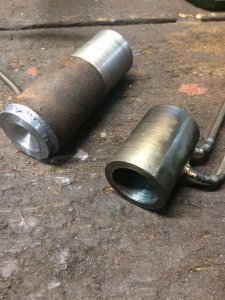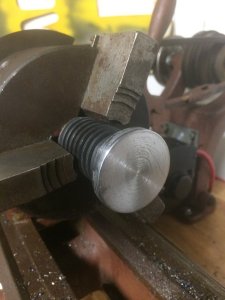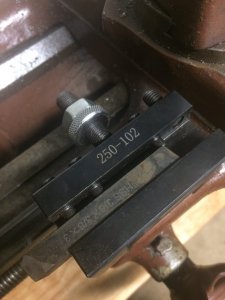To an extent, you just have to accept that many of these old machines just don't produce a fine quality part on their own without jumping through a few extra hoops. On my 9" from 1903, I have to lock the saddle, tighten up everything that doesn't need to move for the particular operation, and use the crossslide if I have any hope of getting a reasonable finish and even then it's not uncommon to hit it with a file if I want a nice smooth finish. It doesn't prevent making good parts, it just takes a little more effort.
You are using an out of date browser. It may not display this or other websites correctly.
You should upgrade or use an alternative browser.
You should upgrade or use an alternative browser.
My new 1943 South Bend 9c lathe
- Thread starter Ryan313
- Start date
Well said. Set up is probably more important than the actual machining.You quickly learn that there are no set and forget adjustments on a lathe. Don
Emery cloth is your friend. DonTo an extent, you just have to accept that many of these old machines just don't produce a fine quality part on their own without jumping through a few extra hoops. On my 9" from 1903, I have to lock the saddle, tighten up everything that doesn't need to move for the particular operation, and use the crossslide if I have any hope of getting a reasonable finish and even then it's not uncommon to hit it with a file if I want a nice smooth finish. It doesn't prevent making good parts, it just takes a little more effort.
I ordered a couple dial indicators! They are cheap, $12 a piece.
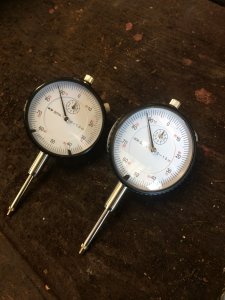
I put one of them in the tool holder/ knurl cutter that came with my quick change tool post kit, it is not very secure. I plan to make a better holder for this. I don’t think it tell me much on the outside of the chuck, but it is 0.006 out there.
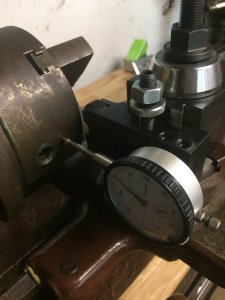
Also, since I have decided to hold off with making anything until I try to go through the lathe I decided to make my wrench holder work. I knocked the flux off of a 5/32 7018 and drilled two holes in the holder. After a couple quick bends and a messy brazing job my temporary holder is done.
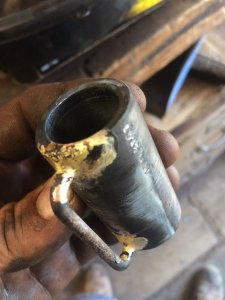

I put one of them in the tool holder/ knurl cutter that came with my quick change tool post kit, it is not very secure. I plan to make a better holder for this. I don’t think it tell me much on the outside of the chuck, but it is 0.006 out there.

Also, since I have decided to hold off with making anything until I try to go through the lathe I decided to make my wrench holder work. I knocked the flux off of a 5/32 7018 and drilled two holes in the holder. After a couple quick bends and a messy brazing job my temporary holder is done.

Here is my second attempt at a wrench holder.
The facing went alright, but some chatter.
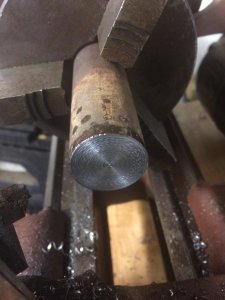
Turning down the outside didn’t go too great... until I remembered to use tail support. Once I had support the horrible chatter I had the first few passes went away.
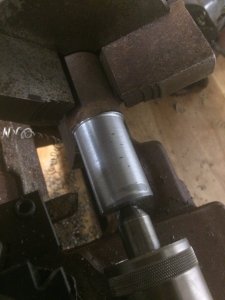
Drilling the hole went smooth.
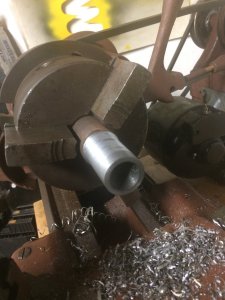
I bought a couple of those thin parting blades, but they are too small to fit properly in the parting tool holder. I ground one of the HHS blanks into a parting tool. I made it about 1/8-3/16 wide, which I think was likely on the large side. Either way, parting went very well!!
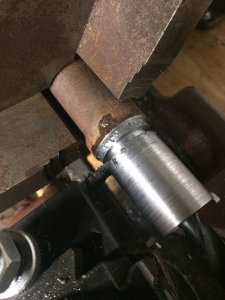
I am not sure where the flex was, but I think I had some during parting. When turning the dial for the cross-slide it kept going, and didn’t feel too tight; however, if I stopped advancing the wheel it still cut for another 10 seconds or so before no chips were made. I simply advanced, stopped, advanced, stopped until the part came off. I used one of the MT2 drills to catch the part.
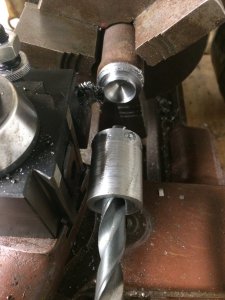
I wanted to have one side of the rod go into the top of the holder, where I did my facing cut. I did not measure anything, I just wung it and made the wall too thin. I wound up with what you see here, I wouldn’t say I am happy with this either to be honest, a 3rd will probably come shortly after. The reason for making the rod higher than the tube, is because with my first holder the wrench was constantly in my side.
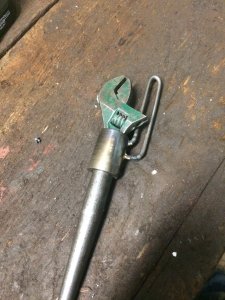
The facing went alright, but some chatter.

Turning down the outside didn’t go too great... until I remembered to use tail support. Once I had support the horrible chatter I had the first few passes went away.

Drilling the hole went smooth.

I bought a couple of those thin parting blades, but they are too small to fit properly in the parting tool holder. I ground one of the HHS blanks into a parting tool. I made it about 1/8-3/16 wide, which I think was likely on the large side. Either way, parting went very well!!

I am not sure where the flex was, but I think I had some during parting. When turning the dial for the cross-slide it kept going, and didn’t feel too tight; however, if I stopped advancing the wheel it still cut for another 10 seconds or so before no chips were made. I simply advanced, stopped, advanced, stopped until the part came off. I used one of the MT2 drills to catch the part.

I wanted to have one side of the rod go into the top of the holder, where I did my facing cut. I did not measure anything, I just wung it and made the wall too thin. I wound up with what you see here, I wouldn’t say I am happy with this either to be honest, a 3rd will probably come shortly after. The reason for making the rod higher than the tube, is because with my first holder the wrench was constantly in my side.

Attachments
What he said! Besides, lathes can be repaired!Make things, they don't have to be to NASA standards to learn. If it doesn't break the lathe or damage your body it is a good learning experience. Don
I'm starting to wonder if you have too much play in the head bearings. You stated that your chatter went away when you used the the live center in your tail stock. On a short piece like you were turning it shouldn't have made that much difference.
At least you are learning your machine and what it takes to turn out good work. Different chuck speeds and feed speeds can have a drastic effect on chatter as well as tool shape and sharpness.
A year from now you'll be an old pro.
At least you are learning your machine and what it takes to turn out good work. Different chuck speeds and feed speeds can have a drastic effect on chatter as well as tool shape and sharpness.
A year from now you'll be an old pro.

I'm starting to wonder if you have too much play in the head bearings. You stated that your chatter went away when you used the the live center in your tail stock. On a short piece like you were turning it shouldn't have made that much difference.
At least you are learning your machine and what it takes to turn out good work. Different chuck speeds and feed speeds can have a drastic effect on chatter as well as tool shape and sharpness.
A year from now you'll be an old pro.
Thanks for the suggestion! I just checked and the spindle moves latterly forward and back. There is an adjustable nut and thrust bearing on the back of the spindle by the change gears. In the refurb manual I got I saw a section that outlined how to adjust it. I ordered new felt for the oilers. I will adjust it when I take it apart to replace the felt.
Good catch!
I am not sure what it is that you are cutting there but it is a sure that the type and grade of the material has as much to do with surface finish as any thing you can do to the lathe. many bolts are not good machinable material for a lathe. Many bolts have rolled threads and get much of their strength from work hardening. Learning to identify material is a life long process. Don
So very true! Even similar materials are wildly different. For example, 303 Stainless Steel cuts almost as smoothly as aluminum, while 316 SS is the devil's own brew!I am not sure what it is that you are cutting there but it is a sure that the type and grade of the material has as much to do with surface finish as any thing you can do to the lathe. many bolts are not good machinable material for a lathe. Many bolts have rolled threads and get much of their strength from work hardening. Learning to identify material is a life long process. Don
Your are getting there,it takes time and practice to get a feel for the work. Can you post a picture of the toolpost as it was setup for this cut? WE might be able to make some suggestions there...I tightened the headstock bearing a little, it works much better! My facing cuts are much smoother. I did not to and turning cuts. Is that the term? I’m not sure. Here is a cut I did a few minutes ago, I’ll have more on what I am doing in a day or three.
View attachment 17263
Yes, turning or profile cuts are what you call the ones on the side of the part. They are actually easier, since the part remains at the same diameter through your cut, while facing means you go from big to small diameter, which means your spindle speed and feedrate are never quite correct! CNC lathes correct for this by speeding up the spindle as the cut goes towards the center, automatically.
Here is a picture of the tool bit, maybe it is sticking out too far. I am aware of keeping the compound centered to try to keep it ridged. Somebody earlier said they had to tighten their gib screws with every cut, maybe tightening my compound gib screws would help too.
Attachments
It's close enough to the holder, although it wouldn't hurt to choke up some more. I do see that you need to grind more front clearance, it looks like your tool might be rubbing on the cut.Here is a picture of the tool bit, maybe it is sticking out too far. I am aware of keeping the compound centered to try to keep it ridged. Somebody earlier said they had to tighten their gib screws with every cut, maybe tightening my compound gib screws would help too.
I'll see if I can find a good tool grinding video for you.
OK, I love this guy's videos:
This Old Tony's style can take some getting used to, but his info and skills are great!Interesting and informative video. Thanks.

